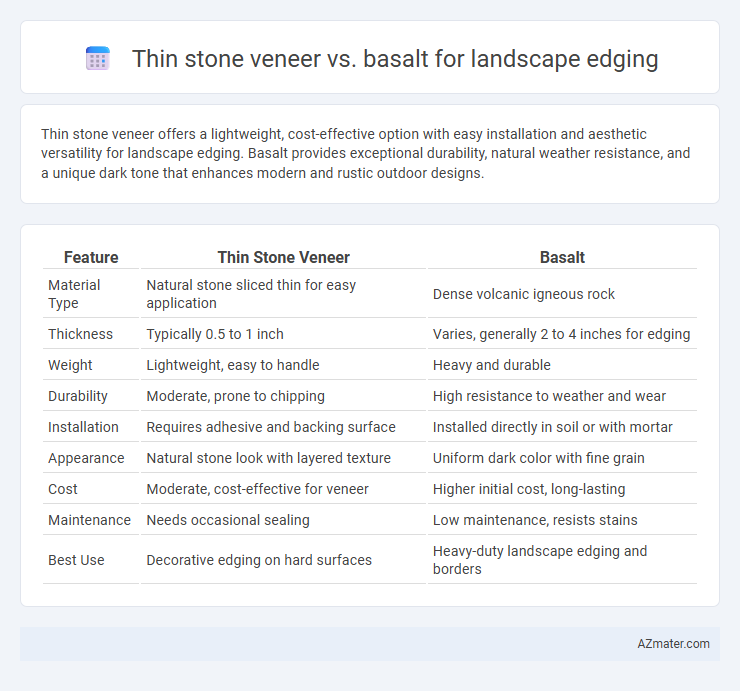Thin stone veneer offers a lightweight, cost-effective option with easy installation and aesthetic versatility for landscape edging. Basalt provides exceptional durability, natural weather resistance, and a unique dark tone that enhances modern and rustic outdoor designs.
Table of Comparison
| Feature | Thin Stone Veneer | Basalt |
|---|---|---|
| Material Type | Natural stone sliced thin for easy application | Dense volcanic igneous rock |
| Thickness | Typically 0.5 to 1 inch | Varies, generally 2 to 4 inches for edging |
| Weight | Lightweight, easy to handle | Heavy and durable |
| Durability | Moderate, prone to chipping | High resistance to weather and wear |
| Installation | Requires adhesive and backing surface | Installed directly in soil or with mortar |
| Appearance | Natural stone look with layered texture | Uniform dark color with fine grain |
| Cost | Moderate, cost-effective for veneer | Higher initial cost, long-lasting |
| Maintenance | Needs occasional sealing | Low maintenance, resists stains |
| Best Use | Decorative edging on hard surfaces | Heavy-duty landscape edging and borders |
Introduction to Landscape Edging Materials
Thin stone veneer offers a lightweight, cost-effective option for landscape edging with natural stone aesthetics, while basalt provides exceptional durability and weather resistance due to its volcanic origin. Both materials enhance garden design by defining spaces and preventing soil erosion, but basalt's dense composition ensures long-lasting performance in harsh climates. Selecting between thin stone veneer and basalt depends on factors like budget, desired appearance, and environmental conditions impacting material longevity.
What is Thin Stone Veneer?
Thin stone veneer is a lightweight, natural stone product typically measuring less than 2 inches in thickness, designed for easy installation on various surfaces including landscape edging. Unlike solid basalt blocks, thin stone veneer offers versatile aesthetic options with a range of textures and colors while maintaining a durable, weather-resistant finish ideal for outdoor use. This material provides cost-effective, elegant edging solutions that can replicate the appearance of heavier stone while reducing labor and foundation requirements.
Understanding Basalt as a Landscape Edging Material
Basalt, a dense volcanic rock known for its durability and natural dark gray to black coloration, is an excellent choice for landscape edging due to its resistance to weathering and erosion. Compared to thin stone veneer, basalt offers superior structural integrity and longevity, making it ideal for high-traffic or exposed outdoor environments. Its naturally rough texture provides better grip and aesthetic appeal while requiring minimal maintenance over time.
Aesthetic Differences: Thin Stone Veneer vs Basalt
Thin stone veneer offers a sleek, uniform appearance with consistent thickness and smooth textures, making it ideal for modern, clean-lined landscape edging. Basalt, with its natural variations in color, texture, and rough, rugged surfaces, provides a more organic, rustic aesthetic that blends seamlessly into natural environments. The choice between the two depends on whether a refined, contemporary look or a natural, earthy feel is desired for the landscape design.
Durability and Longevity Comparison
Thin stone veneer offers moderate durability and is susceptible to chipping and weathering over time, making it less ideal for high-impact or harsh environments in landscape edging. Basalt, a dense volcanic rock, excels in durability with exceptional resistance to abrasion, weather, and frost, ensuring long-lasting performance with minimal maintenance. Choosing basalt for landscape edging guarantees superior longevity and resilience compared to thin stone veneer.
Installation Process: Ease and Requirements
Thin stone veneer offers a lightweight and flexible solution for landscape edging, allowing for easier handling and faster installation on various surfaces with basic masonry skills. Basalt, being a dense and heavy natural stone, requires more labor-intensive cutting, precise placement, and stronger support structures, which can extend installation time and increase costs. Preparation for thin stone veneer typically involves a clean substrate and mortar application, while basalt demands more robust groundwork and specialized tools due to its hardness and weight.
Cost Analysis: Upfront and Long-Term Expenses
Thin stone veneer offers a lower upfront cost compared to basalt, making it a budget-friendly option for landscape edging projects. Basalt, while more expensive initially, provides superior durability and requires less maintenance, leading to reduced long-term expenses. Considering installation costs, thin stone veneer is easier and quicker to install, but basalt's longevity often results in better cost efficiency over time.
Maintenance Needs and Weather Resistance
Thin stone veneer offers low maintenance with minimal sealing and is resistant to cracks but may be vulnerable to chipping under heavy impact. Basalt excels in weather resistance due to its dense, durable nature, requiring little upkeep while withstanding extreme temperatures and moisture without degrading. Choosing basalt ensures a longer-lasting landscape edging solution with superior resilience against weathering and maintenance demands.
Eco-Friendliness and Sustainability
Thin stone veneer offers an eco-friendly option for landscape edging by utilizing less raw material and reducing quarrying impacts compared to solid basalt. Basalt, a natural volcanic rock, is durable and sustainable but involves higher environmental costs during extraction and transportation due to its weight. Choosing thin stone veneer minimizes carbon footprint while retaining the aesthetic and functional benefits of natural stone in sustainable landscaping.
Best Use Cases: Choosing the Right Material for Your Landscape
Thin stone veneer offers versatility and a natural stone appearance ideal for decorative landscape edging in residential gardens, walkways, and patios, providing an elegant finish with relatively low installation cost and ease. Basalt, known for its durability and weather resistance, is best suited for high-traffic areas and commercial landscapes where long-lasting, robust edging is required, especially in climates with harsh environmental conditions. Selecting the right material depends on factors such as aesthetic preference, budget, and the functional demands of the specific landscape setting.

Infographic: Thin stone veneer vs Basalt for Landscape edging
 azmater.com
azmater.com